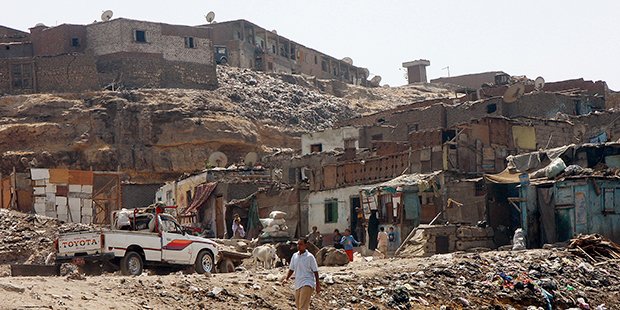There are some 364 “unsafe” areas in Egypt and 1,099 unofficial markets, comprising 37.5% of Egypt’s urban cluster, Minister of Urban Development Laila Iskandar said in a Monday press conference.
“The human condition is the hub of slum development, for slums are not just the result of a housing problem, but also an economic ordeal because those residents migrated from villages seeking jobs,” Iskandar said.
Of the unsafe areas, 26 are life-threatening, 258 are inadequate since they are made of huts, 61 are health-threatening, and 19 lack stable ownership of residence, Iskandar said, citing the ministry’s 2014 statistics.
Some of Egypt’s slums lie in potentially risky areas; under hills, near storm water drains and high-voltage lines.
Millions of Egyptians are estimated to be living in slum conditions, according to the Central Agency for Public Mobilization and Statistics (CAPMAS), especially in Greater Cairo.
Some of these informal residents have been displaced or evacuated a few times in the past few years since concrete buildings in these areas are considered illegal.
Government launches urbanization projects
The Ministry of Urban Development is set to implement six projects to develop slums at a cost of 500 million EGP ($69 million) upon completion in April 2015,” Iskandar told Youm7 on July 12.
Similar projects are scheduled for completion in 2016, adding that the projects include developing 75 slums.
A total of 30 slums in Cairo and Giza are being developed at the cost of 350 million EGP ($49 million), Youm7 reported SDF head Khaled al-Gabarti saying on July 1.
Tight spaces in slums will be improved and facades will be painted in cooperation with the Urban Planning Authority. The youths of the slums will mobilize their abilities towards the betterment of their own residential areas, Iskander added.
The majority of buildings in Egypt’s slums are built using red bricks and streets are too tight for any ambulance or fire truck to pass through.
The Ministry of Urban Development was a department of the Ministry of Housing before it became an independent ministry in Prime Minister Ibrahim Mahlab’s Cabinet, which was appointed last month by newly elected President Abdel Fatah al-Sisi.
Integration or freezing “sprawl of slums”?
The “freezing of the sprawl of slums” is still being studied researched by governmental and non-governmental organizations, Iskandar said. However, Iskandar supports integrating developed slums into the urban community and helping slum residents to develop their skills rather than containing their informal areas.
The idea of “freezing the sprawl of slums” was first proposed as part of the Cairo 2050 project initiated by former President Hosni Mubarak’s son Gamal, who was being groomed to be future president. The project was proposed a few years before the January 25 Revolution, which toppled Mubarak and his government in 2011.
The project aimed to develop Egypt’s capital per “international standards,” prevent the expansion of its slums into farmland and state land, create “axes of movement,” and provide facilities to improve living conditions. It was criticized by the public for “favoring” businessmen and “marginalizing” the poor.
EU cooperation in slum development
The European Union delegation to Egypt announced July 7 that it would provide 1.5 million Euros ($2.04 million) to enhance the standards and range of community services available in four slums in Greater Cairo within the upcoming year.
The projects aim to improve vocational skills for the unemployed and foster income-generating activities, according to the statement.
“[The development measure] is based on the needs of the respective communities in our selected areas. Its participatory approach is unique and includes civil society, local authorities, and the private sector that are working together in the spirit of cooperation to develop these areas,” Minister of Planning Ashraf al-Araby, who was present during the signing of the EU agreement, said.
The informal areas include Ain Shams, Ezbet el-Nasr, Warraq, and Geziret el-Dahab. The grant went to 17 beneficiaries from civil and social groups who met the criteria set by the E.U.
In December 2013, the E.U. signed a 20 million Euro ($27 million) agreement with the Deutsche Gesellschaft für Internationale Zusammenarbeit (GIZ) to develop impoverished slums in Cairo’s Matariya, Giza’s Old Bulaq, and Qalyubia’s Shubra and Khosous.
Additional reporting by Manal el-Esawy.

